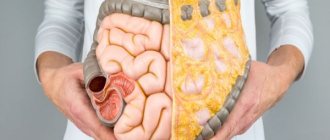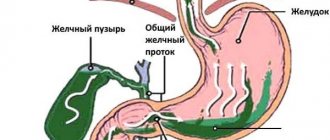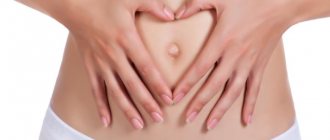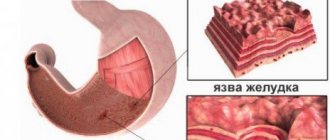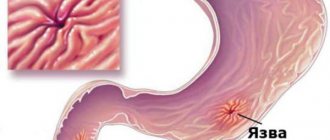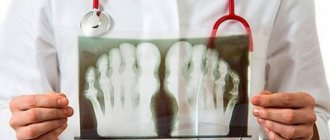One of the types of stomach polyps is hyperplastic, also known as metaplastic. They are the most common type, detected in 70–80% of episodes.
Hyperplastic polyp
Their essence lies in the improper development of the gastric mucosa, which results in the proliferation of its own epithelial cells. The cells of the mucous membrane cease to perform their main functions and begin to divide more rapidly; why this happens is not known exactly. This feature means that such polyps have only a very small chance of degenerating into a malignant tumor, since they still remain native cells of the stomach. Usually the probability does not exceed one percent.
A hyperplastic polyp has quite characteristic histological and macroscopic manifestations, due to which it is difficult to confuse them with others during diagnosis. Against the background of the mucous membrane, they are whitish in color, spherical in shape and smooth surface, often without a stalk. The size varies from 5 to 60 millimeters.
Gastric polyposis
In terms of prevalence, they can be either single or located in groups. With multiple lesions, the disease is called polyposis (about 2-3% of cases).
According to statistics, men are more likely to suffer from this pathology. After the age of 40, the risk of detecting the disease increases, most likely due to decreased immunity and the development of concomitant diseases. Although it sometimes occurs in teenagers.
About polyps and their types
Gastric polyps (K.31.7) are formed from outgrowths of the glandular structure of the gastric mucosa and are benign tumors. They are localized on the inner walls of the stomach, most often in the pyloric region. Their appearance and growth occur without symptoms, but over time, when polyps reach impressive sizes, they can cause stomach bleeding, acute abdominal pain, and difficulties with transporting food from the stomach.
The danger of their occurrence is that they can transform into malignant tumors. According to various statistics, this happens in 10-15% of cases of the disease.
Polyps most often occur at the age of 40-50 years, but they can also occur in young people and even children. The disease has a sexual preference for men.
Need for removal
It is important for patients to understand that the cells in the gastric mucosa have already been changed, and this is an irreversible process. Pathological growths require mandatory treatment.
This is due to the general medical theory - almost all clinicians classify polyps, condylomas, fibroids and other growths of the mucous membrane as precancerous conditions.
A promising direction in the successful treatment of polyps is surgery. Not a single medication, physical therapy, or treatment of gastric polyps with folk remedies can radically solve the clinical problem. The only thing that can be achieved is to reduce the volume of the polyp.
However, if surgical treatment is impossible, doctors take a wait-and-see approach, especially if the volume of growths is within acceptable limits.
Classification of polyps
There are several types of polyps according to morphological characteristics.
The most common is hyperplastic. These are overgrown epithelial cells that cannot be called a tumor. Hyperplastic polyps, although they are 16 times more common than others, cannot develop into malignant formations.
Within this species there are two subspecies: true hyperplastic polyps and polypoid hyperplasia in the cardia.
Polyps from glandular cells are more dangerous - adenomatous. This type of polyp is already considered a truly benign tumor, and therefore there is a risk of transformation into a malignant one. In this type, adenomas of the intestinal, foveolar, pyloric, fundal type, as well as inflammatory fibrous polyp, are separately called.
Based on the number of formations, single (1-3 polyps) and multiple (10-15 polyps) polyposis are distinguished.
According to the location, the pyloric (pyloric) polyp and the polyp of the body of the stomach are distinguished. The first is formed at the junction of the stomach and duodenum.
K20-K31 Diseases of the esophagus, stomach and duodenum
Excluded:
diaphragmatic hernia (K44.-)
(+) The following subcategories are intended for use with categories K25-K28:
.0 - acute with bleeding .1 - acute with perforation .2 - acute with bleeding and perforation .3 - acute without bleeding or perforation .4 - chronic or unspecified with bleeding .5 - chronic or unspecified with perforation .6 - chronic or unspecified with bleeding and perforation .7 — chronic without bleeding or perforation .9 — not specified as acute or chronic without bleeding or perforation
Included:
Esophageal abscess Esophagitis:
If necessary, identify the cause, use an additional external cause code (class XX)
Excluded
: esophageal erosion (K22.1), reflux esophagitis (K21.0) esophagitis with gastroesophageal reflux disease (K21.0)
K21 Gastroesophageal reflux disease
K21.0 Gastroesophageal reflux disease with esophagitis
K22 Other diseases of the esophagus
Excluded:
varicose veins of the esophagus (I85.-)
K22.0 Achalasia cardia
Excluded:
congenital cardiospasm (Q39.5)
K22.1 Esophageal ulcer
Erosion of the esophagus Esophageal ulcer:
- NOS
- called:
- chemicals
- medicines and medicines
- fungal
- peptic
If necessary, identify the cause, use an additional external cause code (class XX)
K22.2 Esophageal obstruction
Esophageal compression Esophageal narrowing Esophageal stenosis Esophageal stricture
Excluded:
congenital stenosis and stricture of the esophagus (Q39.3)
K22.3 Perforation of the esophagus
Excluded
: traumatic perforation of the (thoracic part) of the esophagus (S27.8)
K22.4 Esophageal dyskinesia
K22.5 Esophageal diverticulum
Excluded
: congenital esophageal diverticulum (Q39.6)
K22.6 Gastroesophageal rupture hemorrhagic syndrome
Excluded
: Barrett's ulcer (K22.1)
K22.8 Other specified diseases of the esophagus
K22.9 Disease of the esophagus, unspecified
K23.0* Tuberculous esophagitis (A18.8 +)
K23.8* Lesions of the esophagus in other diseases classified elsewhere
K25 Stomach ulcer
See (+) subcategories at the beginning of the page
erosion (acute) of the stomach, peptic ulcer:
- pyloric part
- stomach
If it is necessary to identify the drug that caused the injury, use an additional code for external causes (class XX)
acute hemorrhagic erosive gastritis (K29.0) peptic ulcer ulcer NOS (K27)
erosion (acute) of the duodenum, peptic ulcer:
- duodenum
- postpyloric part
If it is necessary to identify the drug that caused the injury, use an additional code for external causes (class XX)
Where do they come from?
Polyps appear as a response to inflammation of the stomach walls.
The risk of illness is higher:
- In middle-aged and elderly people (40 and older);
- For stomach infections caused by bacteria (including the well-known Helicobacter pylori);
- If there is a hereditary predisposition to colon cancer;
- With long-term use of certain medications (for example, proton pump inhibitors);
- For chronic gastritis and poor nutrition.
Prevention
As a preventive measure, it is important to carry out timely treatment of stomach diseases.
If the bacteria Helicobacter pylori is detected, antibiotics are required. It is also important to follow a diet, exclude spicy foods from the diet, give up alcohol, smoking, and reduce the use of anti-inflammatory drugs that have a negative effect on the gastric mucosa.
Author : Marina Nagornaya, especially for the site Moizhivot.ru
https://youtu.be/m8l8xuJszH0
Symptoms
As mentioned above, initially polyps do not show themselves by any symptoms. Later the disease manifests itself:
- Unpleasant sensations and pain in the epigastric region;
- Increased salivation;
- Decreased or lack of appetite;
- Belching and heartburn;
- Nausea and vomiting;
- Pain during meals, which can radiate to the back;
- Problems with bowel cleansing (constipation and diarrhea);
- Bloating;
- Unpleasant taste and odor in the mouth;
- General weakness and weight loss.
In particularly advanced cases, when polyps reach very large sizes, more serious symptoms appear:
- Dark, tarry stool, sometimes mixed with blood;
- Vomiting blood;
- Sharp, frequent pain in the abdomen that radiates to the lumbar region and chest.
Features of development
The exact cause of the appearance of polyps has not yet been identified. Predisposing factors include:
- infection with HPV, Helicobacter pylori;
- genetic predisposition;
- unfavorable environment and addiction to bad habits;
- treatment with certain medications;
- nutritional disorders and gastrointestinal pathology.
Due to infection or metabolic disturbances, an imbalance occurs between proliferation (overgrowth) and differentiation (stratification). Against the background of increased regeneration, the cells do not exfoliate in time, which causes the formation of a polyp.
Diagnostics
Due to the absence of symptoms in the early stages, polyps are most often discovered by chance. When the patient complains of abdominal pain and discomfort, it is difficult to determine the diagnosis - the similarity with gastritis and ulcers is too strong. Therefore, special diagnostic methods are used.
- FGDS. This method allows you to detect a polyp using a special device - a gastroscope - and take a biopsy.
- General clinical blood test. If polyposis causes bleeding in the stomach, a blood test will show signs of anemia.
- Fecal occult blood test.
- X-ray of the stomach. Thanks to this study, the outlines of the polyp can be determined.
- Serological tests for antibodies to Helicobacter pylori infection.
ethnoscience
The most effective home recipes for detecting polyps in the stomach are the following.
- You need to take ten grams of dried celandine per two glasses of boiling water. Leave for two hours, filter and drink two teaspoons four times a day.
- Take fifty grams of viburnum fruits for two glasses of boiling water. Leave for an hour. Take two tablespoons three times a day, regardless of meals.
- One of the proven folk methods for treating polyps in the stomach is the daily consumption of a handful of fresh viburnum berries.
- A fruit drink made from them with the addition of honey, which is consumed twice a day, half a glass, has an excellent medicinal effect.
- You should take one kilogram of cow butter for an equal amount of honey. Place on the fire for three hours until a homogeneous mass is obtained. Allow to cool and then store in the refrigerator. Take twenty grams before meals. You need to take the drug on an empty stomach, one tablespoon at a time.
- They take the juice squeezed from two lemons, five hundred grams of honey and olive oil, mix it, and then put it in the refrigerator. Take twenty grams four times a day before meals for three weeks.
- You need to take one hundred grams of ground pumpkin seeds and the whites of seven hard-boiled eggs. Homogenize and mix with half a liter of olive oil. Heat and take for five days. Take a week break and resume treatment.
When correcting the occurrence of stomach polyps, it is recommended not to neglect any effective methods of combating the disease. Requires the use of pills, diet, home recipes, physical therapy, exercise therapy or other methods. If they are ineffective, it is necessary to resort to surgery.
Treatment
The following treatment methods are used in the fight against polyps:
- Medication. But you need to understand that medications will not relieve the patient of the polyp, but will only alleviate the symptoms. If the polyp is caused by gastritis, medications may be aimed at treating this disease. This method of treatment also helps to improve the motility of the stomach and intestines and eliminate disturbances in the functioning of the stomach.
- Electroexcision. A special device (loop) is inserted through a gastroscope, which is used to pick up the polyp(s) at the base, cauterize and remove the dead formation.
- Gastric resection. This method is used only in cases of severe neglect of the disease and large size of the polyp. This is a surgical method that involves removing the part of the stomach in which the disease recurs, there are too many polyps or they are malignant.
Recovery period
After 10-14 days after surgery, it is worth undergoing gastroendoscopy to monitor the condition of the inner surface of the stomach. If abdominal surgery was performed, the examination is carried out later, after the incisions have healed. In the first year, gastroendoscopy is performed 2-4 times, in the subsequent period 1-2 times.
In the first month after surgery, stick to the diet prescribed for peptic ulcers - Table No. 1. If there are concomitant disorders of the stomach, stick to the diet longer, do not cancel it without consulting your doctor.
What are erosions in the antrum of the stomach?
Have you been struggling with GASTRITIS and ULCERS for many years without success?
Head of the Institute: “You will be amazed at how easy it is to cure gastritis and ulcers simply by taking it every day.
Erosive lesions of the stomach are not uncommon today, but erosions of the antrum of the stomach are diagnosed more often than any other. They are characterized by thinning or ulceration of the epithelium of the mucous membranes of the organ.
Most often, this disease affects young people who often succumb to stress and lead an active social life. There are:
Complete erosions of the antrum of the stomach. They are small growths resembling polyps, cone-shaped with the presence of depressions or ulcerations in their center. The mucous membrane surrounding them swells and turns red, although sometimes no changes are observed.
- Incomplete or superficial erosions are flat defects of the gastric epithelium of various sizes and shapes. Their edges are smooth, but due to hyperemia and swelling of the surrounding tissues, a kind of narrow rim is formed.
- Hemorrhagic. These ulcerations appear as small dots on the mucous membranes, much like needle pricks. Their color ranges from muted cherry to bright red, and around the ulceration itself, as a rule, a small rim of hyperemic tissue is formed, which is often almost twice the size of the defect itself. It is the edge of the erosion that bleeds.
- increased secretion of hydrochloric acid;
- insufficient secretion of mucus that protects the walls of the organ;
Our readers successfully use Monastic Tea to treat gastritis and ulcers. Seeing how popular this product is, we decided to bring it to your attention. Read more here...
Important: complete erosions are most often multiple and are a consequence of a chronic inflammatory process in the mucous membranes, which should be paid attention to during an endoscopic examination.
Acute form
Acute erosions of the antrum of the stomach develop as a result of:
Reasons for development
Thus, the reasons for the formation of ulcerations are:
- malnutrition;
- excessive consumption of acidic foods, such as apples, citrus fruits, preserves, bite-sized foods, etc.;
- taking certain medications;
- certain chronic illnesses;
- metabolic disorders;
- stress.
Often the formation of ulcerations in the mucous membranes of the stomach is the body’s reaction to the progression of liver diseases or the development of neoplasms in the large intestine.
Signs
This disease manifests itself:
- the appearance of acute pain in the center of the abdomen;
- nausea and vomiting;
- frequent heartburn.
If the patient has developed hemorrhagic erosions, he suffers from:
- presence of blood impurities in stool and vomit;
- anemia;
- lack of hemoglobin;
- weaknesses.
Treatment
Initially, all patients are prescribed a gentle diet, excluding the consumption of any food that can irritate the gastric mucosa. We recommend reading the article about the diet for gastric erosion, from which you can get detailed information about prohibited foods, as well as familiarize yourself with the approximate daily diet.
After this, they move on to eliminating the diseases that provoked the development of erosions and eliminating the unpleasant symptoms of the disease. For this purpose, patients are prescribed:
- antacids;
- proton pump inhibitors;
- prokinetics;
- enveloping agents;
- gastroprotectors, etc.
In cases where the treatment is chosen correctly and the patient strictly adheres to the diet, the mucosal defects heal and disappear without a trace within a few weeks.
Attention! If erosion of the antrum of the stomach is not treated in time, the disease can become chronic.
Chronic form
Chronic erosions of the antrum of the stomach manifest themselves more mildly than acute ones. They are not characterized by severe pain that twists a person, but they are more often hemorrhagic, so patients usually experience bloody vomiting and stool. Thus, the chronic form of the disease poses a greater danger to the health of patients than the acute form and, therefore, requires a more careful attitude.
Attention! Lack of treatment for erosion can cause perforation of the stomach wall, ulceration of nearby organs, and the formation of polyps.
Since chronic erosions can heal not only for several months, but also for years, patients have to almost constantly be on a gentle diet. This usually causes anxiety and stress, which worsens the course of the disease. As a result, a kind of vicious circle is formed, which is not easy to break.
Advice: all patients with erosions need to adhere to a diet, but for those who suffer from chronic ulceration of the gastric mucosa, it should become a way of life. Therefore, they are recommended to spend time and energy searching for recipes for dishes that will not only be healthy, but also tasty.
Patients are also prescribed symptomatic treatment and therapy for diseases that provoked the development of erosion. If the cause of the formation of ulcerations is the gram-negative bacterium H. pilory, it is mandatory to study its sensitivity to various antibiotics and only then prescribe appropriate medications.
Postoperative recommendations
Sometimes the formation of polyposis is accompanied by a fairly visible clinical picture, for example, the appearance of sharp attacks of pain in the epigastric region, spreading to other areas. In this case, you need to urgently examine the stomach polyp: endoscopic or laser removal may be the only correct solution.
Signs indicating removal of a polyp in the stomach (endoscopy):
- Hyperplasticity of pathological formation in the absence of a clear clinical picture.
- Detection of adenomatous growth in the absence of clinical indications.
- In case of pronounced symptoms.
- If progression of polyp growth with a change in its configuration is detected.
Gastroenterologists at the ABC Clinic in Moscow make a decision on prescribing removal of the growth (laser polypectomy) on an individual basis with each patient, taking into account the characteristics of the layer, the collected medical history and his well-being.
The main guarantee of quick recovery and successful results after laser treatment is compliance with the recommendations of the gastroenterologist. After all, the surgeons of the ABC Clinic in Moscow invested all their skill and professionalism during the removal, and all other achievements in terms of rehabilitation depend on the patient himself and his disciplined attitude to the advice of doctors.
For successful recovery you need:
- Follow the diet strictly according to the specified list.
- Quit bad habits.
- Monitor the condition through timely diagnosis and examinations. This applies to ultrasound, x-rays and tests.
- React instantly to inadequate and atypical signs.
Endoscopic removal of a gastric polyp involves recovery within a month, and sometimes two. The reason for such a large difference in the rehabilitation period may be the age criteria of the patients, the extent of the surgical intervention, the stage of the disease and possible complications after the operation.
Dietary nutrition after eliminating the formations includes:
- Complete refusal to eat during the first 24 hours.
- Take only liquid substances on the second day, but only water and special milk compositions.
- From the onset of the third day and for eight weeks, the doctor prescribes an expanded diet.
During rehabilitation you are allowed to consume:
- weak meat broths, light soups;
- all types of cereals;
- dairy products, including fermented milk;
- boiled and stewed vegetables and fruits (only sweet varieties);
- homemade sweet juices;
- baked fish, meat (but boiled is better).
All fried, spicy, smoked foods, alcohol, unpasteurized milk, bread and pastries, legumes, store-bought juices and purees, carbonated drinks (including water), cabbage in any form are prohibited in the diet.
Large polyps, and in addition those that cause doctors to suspect the presence of cancer cells, are removed surgically. When it is necessary to get rid of one or more small polyps, endoscopic polypectomy or laser removal methods are used. Sometimes tumors cannot be dealt with in one session, and then several visits to the doctor will be required. If the polyposis affects large areas, it is removed during abdominal surgery.
How polyps are removed
Whatever removal method the doctor chooses, all manipulations are performed using anesthesia. Open gastric surgery may require general anesthesia; for polypectomy, local anesthesia is sufficient. The growths are cut off layer by layer with biopsy forceps or a diathermic loop. This procedure is used even if there is a polyp on the leg of the stomach, in a hard-to-reach place. If there is a possibility of bleeding or complications, the procedure is stopped immediately.
We invite you to familiarize yourself with Removing warts using the radio wave method - real reviews
Consequences
If you have been diagnosed with a polyp, and even more so if cancer cells were found in it during a biopsy, you should not hope for a miracle. This growth will not go away on its own; you need to get rid of it quickly. Polyps that are treated or removed in a timely manner, as a rule, do not cause relapses, however, experts recommend adhering to therapeutic nutritional standards and conducting examinations of the gastrointestinal tract twice a year to be sure that tumors have not reappeared.
Many clinicians believe that the main indication for removal is the results of histology and biopsy. Read what a polyp biopsy usually shows here. However, this is not always true. A biopsy is often done directly during surgery to eliminate the risks of infection, damage to the integrity of the polyp, and complications.
Today, the indications for surgery are the following:
- Drug treatment for stomach polyps did not bring the expected effect;
- Constant relapses after non-invasive techniques;
- Exacerbation of diseases of the epigastric organs;
- Impossibility of drug therapy;
- A burdened clinical history of the patient (may be a contraindication);
- Risks of malignancy;
- Large multiple polyps.
Note! An important factor is the wishes of the patient himself. If the disease constantly provokes exacerbation of chronic diseases of the gastrointestinal tract and depresses general well-being, then the main prevention of relapse of polyposis is surgery.
If there is one polyp in the stomach and its volume is barely visible, no more than 0.4 mm, then there may be 2 main options: expectant management and surgery. Theoretically, the larger the area of the stomach cavity affected by polyps, the higher their likelihood of malignant degeneration. Other complications include pinching, bleeding, and acute intense pain. This can also apply to small tumors.
In practice, there are known cases of malignancy of the villi of polyps, which outwardly resembled benign growths. Size does not matter at all in the case of cancer.
The risk group includes persons:
- with a genetic predisposition,
- with diseases of the epigastric organs.
In addition, late diagnosis also poses a danger. In the absence of symptoms, polyps grow and cells can degenerate.
Important! Gastric polyposis is a disease with an unpredictable clinical prognosis, so radical treatment is the only prevention of oncology in the future.
After collecting the patient’s medical history, studying his complaints, studying data from laboratory and instrumental studies, the adequacy of surgical treatment is assessed.
If there are appropriate indications for the operation, the surgical intervention itself begins.
Abdominal surgery
Abdominal surgery is a full-scale surgical intervention, and therefore places the highest burden on the body.
The algorithm looks like this:
- Administration of anesthesia (general anesthesia is usually used);
- Dissection of the tissues of the peritoneum and stomach (layer-by-layer excision technique);
- Removal of a polyp or part of the stomach with a polyp (with absolute resection);
- Antiseptic treatment;
- Suturing the wound surface with threads (use the reverse sequence);
- The patient is transferred to intensive care, and then to the ward.
The operation refers to the cavity method of polyp removal. Usually such operations require serious reasons.
The intervention is complicated:
- Long recovery period;
- Problems with the cardiovascular system, lungs;
- Bleeding;
- Infection.
Alternative - endoscopic methods of intervention are gentle.
They are carried out according to the following scheme:
- Administration of anesthesia;
- Expansion of the oral cavity and insertion of an endoscope;
- The device fixes the area with the polyp;
- The polyp is excised (with a loop) and cauterized.
Endoscopic methods are suitable for removing single pedunculated polyps. In case of malignancy of a flat neoplasm, gastric resection is performed. In case of cancerous degeneration of a gastric polyp, complete removal of the stomach is often prescribed.
Large volumes of operations are almost always complicated. Patients often become disabled and their quality of life decreases. However, such interventions preserve the most valuable thing - human life.
Anesthesia used
When undergoing surgery of any volume, patients are given general anesthesia through intravenous administration or the use of an oxygen mask. The type of anesthesia and the duration of its effect depend on the duration of the intended operation and on the progress of the intervention itself.
On average, the operation lasts about 30 minutes, but the time can be increased at unexpected moments during the course of the surgical procedure.
If surgical resection or removal of the stomach takes place, the time can be increased to 60 minutes, since time is required to install a stoma or form an organ-replacing cavity.
Both endoscopic and abdominal operations take the same time. Surgeons try to significantly reduce the time the patient spends under anesthesia - this is especially important when operating on a child.
After surgery, it is important for patients to follow all doctor's recommendations. The success of treatment depends not only on the professionalism of the doctor, but also on the discipline of the patient.
For successful post-operative recovery, the following recommendations are required:
- Dietary food (we have already written about what you can eat after removal of a stomach polyp in a separate article);
- No bad habits;
- Regular dynamic monitoring (X-rays, ultrasound, tests);
- Timely response to the appearance of atypical symptoms.
The patient’s body recovers on average 30-60 days. It all depends on the extent of the operation and the age of the patient. In case of early or late postoperative complications, symptomatic treatment is carried out.
Unfortunately, surgery is not an absolute guarantee against recurrence of gastric polyposis. The prognosis after removal is mostly favorable, but patients should follow all instructions. This will allow timely relief of unpleasant symptoms, as well as get rid of recurrent processes.
You can make an appointment with a doctor directly on our website.
- If the formations are at an early stage, they can be removed using conservative (non-surgical) methods. The patient must follow a strict diet. Spicy, salty foods are excluded from the diet. It is strictly forbidden to use preservatives and pickled foods. During the diet you need to give up coffee.
Types of antral gastritis
Gastritis of the antrum of the stomach is a disease related to a type of chronic inflammatory process localized in the antrum of the stomach, hence the name.
The antrum of the body of the stomach performs the function of reducing the acidity of digested food before excreting it into the duodenum. An additional function is peristaltic. Contraction of smooth muscle moves the bolus of food from the stomach to the small intestine. The developing inflammatory process leads to the formation of foci of atrophy on the mucous membrane and disruption of digestive functions. Antral gastritis often develops into focal superficial and atrophic.
Reasons for the development of the disease
The main cause of this type of gastritis is pathogenic microorganisms. A common pathogen is Helicobacter pylori, which leads to an inflammatory process. Due to the development of inflammation, the acidity of the gastric contents increases. Together with the food bolus, hydrochloric acid from the stomach enters the cavity of the small intestine, causing an inflammatory process. In the pyloric region, acidification of the environment occurs, leading to aggravation of pathological processes and an increase in atrophic foci. As a result, connective tissue scars form in place of atrophic foci.
Another cause of dysfunction of the secretory glands of the antrum of the stomach is an autoimmune process that has developed in the body, leading to a decrease in acidity in the stomach cavity.
Morphological forms
A classification of antral gastritis has been created, based on morphological changes in the mucous membrane:
- The superficial form of antral gastritis is expressed in damage to the superficial layers of the epithelium. The submucosal layer and deep layers are not affected, the gastric glands are not changed, and no scars remain after healing.
- Erosive antral chronic gastritis affects the inner surface more deeply. The clinical picture is similar to that of the catarrhal form of gastritis. The inflammatory process can be extensive and deep, affecting the glands of the stomach, leaving behind scar changes. The lesions are multiple and do not heal for a long time.
- The hyperplastic form is characterized by the development of proliferation of the epithelial layers of the mucous membrane in the pyloric region of the stomach. The glandular epithelium forms many cystic enlargements or polypous growths.
- In the focal form, individual areas of the antrum of the stomach are affected. The phenomena of atrophy predominate.
- Catarrhal gastritis is essentially similar to superficial gastritis.
- Gastritis is divided into acute and chronic forms. The chronic form can occur in a moderate or severe degree.
Clinical course
The initial stages of the disease are characterized by mild symptoms. Pathogenetic and pathomorphological changes in the first stages are not too significant, the functional ability of the gastric glands is not too much changed. The acidity level of gastric juice can be normal or slightly elevated.
- With the current progression of the disease, the patient’s feeling of subjective discomfort will increase. The first characteristic clinical sign is pain in the epigastric region. Typically, “classic” pain with gastritis occurs an hour and a half after the patient eats. Subsequently, hunger pains appear. The nature of the pain can be sharp, cramping, stabbing or cutting. The acidity level increases greatly at this time, not enough mucus is produced to protect the walls of the stomach, and erosions appear on the surface of the mucosa. Erosive antral gastritis is characterized by vivid clinical symptoms; the active process can develop into an ulcer.
- The appearance of pain is accompanied by digestive disorders - belching with a sour smell, an unpleasant taste in the mouth, discomfort in the stomach. In the intestines, bloating and flatulence, constipation or loose stools appear. With antral reflux gastritis, bile refluxes into the stomach cavity, which is characterized by burning pain and belching, bloating.
- In advanced stages, ulcerations appear on the walls of the stomach that can bleed and lead to massive blood loss.
- Improper nutrition can intensify and provoke clinical manifestations of the disease. For example, spicy, salty or smoked foods, alcoholic drinks, carbonated sweet waters, sour fruits. It is strictly not recommended to consume lemons, grapes, and sour apples.
Certain forms of antral gastritis
The article discusses a list of common forms of antral gastritis, the main clinical features and methods of treatment and prevention.
Chronic antral gastritis
If a patient develops chronic antral gastritis, the patient may not be aware of what is happening for a long time. The first clinical symptoms begin to appear when the pylorus ceases to cope with the processing of food masses before evacuating them into the small intestine. The patient begins to experience the first discomfort. The inflammatory process in the antrum and an increase in the level of acidity that characterizes gastric juice leads to weak alkalization of the food bolus and the entry of insufficiently processed food into the duodenum. In the cavity of the duodenum and in the small intestine, the level of acidity must be significantly lower, this leads to an imbalance in its functioning and irritation of the intestinal walls. As a result, the intestines undergo an inflammatory process.
The main clinical manifestations are a clear decrease in appetite, a feeling of heaviness and fullness in the stomach, disruption of the normal character of stool, and dyspeptic disorders. Signs of general asthenia are added - fatigue, headache, dizziness, decreased immunity, low hemoglobin.
If catarrhal gastritis takes on an erosive form, the symptoms become much brighter and more varied. A couple of hours after eating, the epigastric area begins to hurt. Pain can be caused by poor diet. The abdomen becomes bloated, tense, and the patient experiences nausea or heartburn, belching, constipation or diarrhea. Body weight is noticeably reduced. Appetite remains low.
Epidemiology
Hyperplastic polyps of the large intestine make up up to 90% of all polypous formations of this localization (according to another version - 30-40%); as a rule, they are formed in the large intestine (rectum and sigmoid colon).
Stomach polyps are most often found in men after 50-60 years of age, although, according to practicing gastroenterologists, this pathology is detected with almost equal frequency in patients of both sexes, including young people.
It is generally accepted that in the stomach and intestines, hyperplastic polyps are found one and a half dozen times more often than adenomatous ones. However, some clinical studies (based on histology data) have shown that hyperplastic polyps are detected in patients only 10-12% more often than adenomatous ones. Moreover, in most cases, hyperplastic polyps of the stomach are single (according to other sources - multiple).
Statistics on hyperplastic uterine polyps (endometrial hyperplastic processes) are also ambiguous: according to some data, these formations on the mucous membrane of the uterus, cervical canal and cervix are detected in 5% of patients, according to others – in almost a quarter.
Oncologists consider true adenomatous polyps formed during epithelial meta- and dysplasia, and hyperplastic polyps are defined as pseudopolyps or polyp-like formations, the appearance of which is associated with focal hyperplasia (increased proliferation) of cells of the germ layer of the mucous epithelium.
Although the exact mechanism of inheritance has not yet been determined, as clinical practice shows, in at least 5% of cases the causes of a hyperplastic polyp lie in a genetically determined predisposition.
But, basically, the etiology of the appearance of such polyps is associated with inflammatory diseases of the abdominal organs and gastrointestinal tract structures. Hyperplastic esophageal polyp, which accounts for 8-12% of cases of gastrointestinal polyps, most often occurs with chronic inflammation of the esophageal mucosa (esophagitis) and gastroesophageal reflux disease (GERD). The predominant localization is the upper part of the esophagus and the area of the cardiac sphincter.
Epithelial hyperplastic polyps of the stomach can form due to any form of gastritis, primarily atrophic, hypertrophic or hyperplastic, autoimmune inflammation of the gastric mucosa, gastric ulcer, as well as in the presence of food allergies. Polyps are soft, have a stalk, protrude into the lumen of the stomach, the most common place for their location is the cardiac, pyloric and antral sections.
Among the causes of such a rather rare pathology as a hyperplastic polyp of the duodenum, which is most often localized in its bulb, gastroenterologists note duodenitis or reflux gastritis. A hyperplastic polyp of the gallbladder is associated with cholecystitis, pathologies of the biliary tract and cholelithiasis, as well as liver diseases (impaired synthesis of bile acids).
The most common localization of focal hyperplasia in elderly patients is the large intestine and, accordingly: hyperplastic polyp of the large intestine (proctologists call it metaplastic), colon, which is a part of the large intestine, and also the cecum. Most often they accompany enterocolitis, nonspecific ulcerative colitis and Crohn's disease. Polyps come in different sizes (on average 2-5 mm) and shapes; they can be on a thin stalk or protrude into the intestine due to an elevation on a fairly wide base. Also read - Colon polyps
In the bladder, the formation of a hyperplastic polyp can be triggered by stagnation of urine, chronic cystitis, urolithiasis, and prostatitis. Urologists even identify a chronic form of polypous cystitis, which can develop in men after repeated catheterization of the bladder.
Gynecologists explain the reasons why women often develop a hyperplastic polyp of the uterus by the physiological specificity of its internal mucous membrane (endometrium), which during childbearing age exfoliates monthly and comes out with menstrual flow, and then - through cell proliferation - is restored. Conditions for endometrial polyps occur when estrogen levels are elevated, there are inflammatory gynecological diseases, and also due to damage to all layers of the endometrium due to its curettage during abortion.
More information about polyps of other localization in gynecology – Polyps of the cervical canal and Polyps of the cervix
